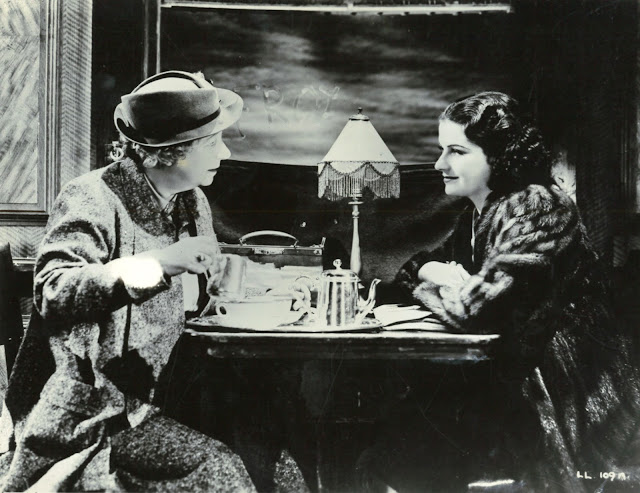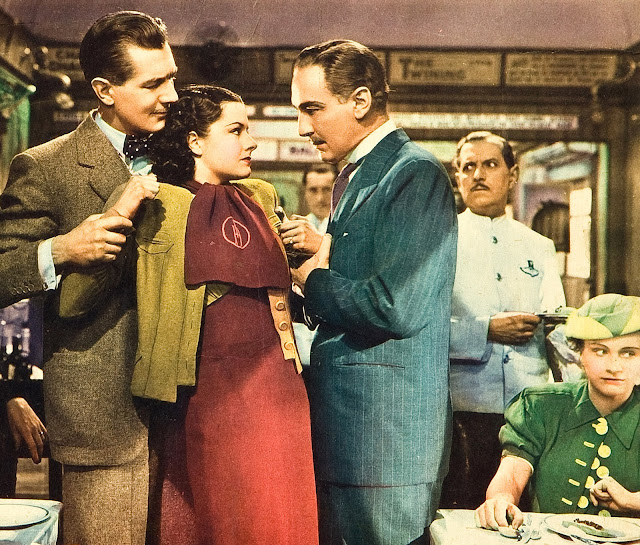Brit Trainload Of Hitchcock
The Lady Vanishes (1938) Still Plays Strong
We had an old radio station that became an art gallery, then was given over to model railroaders who built a scale town through which trains ran, their tabletop consuming near-whole of the building. It's a remarkable display, and evidence of what hobbyists can do where given plentiful space to cut loose. How often do personal obsessions have a practical application? The man who cured polio could have answered that, while ones of us gone on old movies and mini-choo-choos must forever wonder if what we do could matter a hoot to posterity. One instance where play toys did serve practical use was Alfred Hitchcock's opening sweep for The Lady Vanishes, his camera travel over mini-rooftops an endearing sleight-of-hand. Someone, or some team, had to build all this time-and-place setting for opening seconds that get The Lady Vanishes underway. There are toy cars that move and even toy people whose arms go up/down. It's clearly fake to us, especially with aid of Blu-Ray, but what marvelous ingenuity! Think of Hitchcock down on the floor making adjustments --- he'd not have delegated this job and missed all the fun. I'll bet AH designed every intricate detail of this built-to-scale set. Imagine having to tear it all down after shooting and discard the lot. Surely he kept a few souvenirs.
Criterion's booklet with The Lady Vanishes has fine essays by Geoffrey O' Brien and Charles Barr. O' Brien mentions that the project was originally set for American director
Hitchcock like any director could not get beyond writing that was misjudged. Weak pictures were made so by weakness in his stories, Hitchcock "touches" but a mask for moments not supported by the whole. There is no Hitchcock that does not have dynamic scenes, plenty more than one in fact. I wonder how much guidance Frank Launder and Sidney Gilliat got or needed from Hitchcock. These writers came to him already brilliant. What they'd do later for other directors (Night Train To Munich, Green For Danger) could be compared with the best of Hitchcock. The Lady Vanishes was a spy yarn like most of what Hitchcock had done since breakout of The Man Who Knew Too Much. He was clearly too major a talent for US companies not to steal, each of AH thrillers an audition toward domestic employment. Clipped-Brit-chat was all that kept them at distance from stateside provincials. Otherwise it was clear that Hitchcock could be refined for Yank consumption, his instinct for crowd-pleasing right up our alley.
 |
| One-Sheet For United Artists' 1952 Reissue |
 |
| A Janus Standby For Art Houses From The 60's Forward |









10 Comments:
Charles Barr "War Declared". I'm glad to see Charles still analyzing film. When there were only two books on Laurel & Hardy in the early 70's, Barr's book was welcome and interesting and contained addresses of many film companies to whom I subsequently surrendered my teen aged labor.
Ha,ha! Have seen THE LADY VANISHES many, many times, love it, love everything about it. BUT my single favorite bit in the whole darn thing is that great introductory sweep over the miniature set! Love that stuff. His earlier thriller NUMBER 17 is, objectively, incomprehensible, but I'm crazy about that chase finale with a toy bus, train and ferry. Why in the world at this late date do I find something like that as thrilling as anything in a MISSION IMPOSSIBLE movie?
Your observations about Hitchcock and serious espionage themes are astute. The guy pretty much re-invented the spy genre first over there then over here, twenty years later kicked off the James Bond era with NORTH BY NORTHWEST, then when everyone else got all spy-crazy he seemed at sea on the subject! TORN CURTAIN and TOPAZ as examples!
Margaret Lockwood remote? Not to Stinky!
If memory serves, there's another huge miniature in YOUNG AND INNOCENT involving a car chase and a train.
There was a disastrous 1979 remake of LADY VANISHES that underscored the big things Hitchcock got right:
-- The remake used real trains rolling through beautiful real locations, looking more inviting than mysterious. Hitchcock's models speeding through the darkness suggested there was no safety and perhaps not even terra firma outside the train. It was like being sealed in an airplane or spaceship.
-- The remake's little band of villains had defined personal motives. I think their deal was keeping the Nazis from learning about a family member tipping data to Miss Froy, which reduced them to standard baddies constrained by resources and a need to avoid the real authorities. Hitchcock's "not-Nazis" were all the more ominous as you eventually couldn't be sure of anybody, not even a nun. We keep seeing new signs of their influence and power ... and of how far they're willing to go, finally abandoning deception and rerouting a train car full of foreign tourists into an ambush. No need for doubletalk about vital secrets or bluster about orders from The Highest Levels. We SEE the danger and the stakes edging upwards, increasing the odds against our heroes. The heroes -- and the audience -- never get a clear picture of what they're up against; only that they've underestimated it at nearly every turn.
-- The leads, Cybill Shepard and Elliott Gould, were mock screwball characters who cancelled each other out. Their mutual "wackiness" also neutered the strange doings around them. Hitchcock gave us a sensible young woman resigned to a dull marriage, and a plausibly smug young man. There was friction, but it was quiet and naturalistic. Slightly off events became infinitely more menacing when happening to polite people accustomed to a rational world.
"How often do personal obsessions have a practical application? The man who cured polio could have answered that..."
A few names could be mentioned for defeating polio, but top of the list is certainly Dr. Jonas Salk. It's a name which should be remembered over and over. I'm old enough to recall the terror which the word "polio" would strike in everyone, particularly parents. Dr. Salk lifted that terror better than even a Van Helsing might have.
Jonas Salk was a great man and a hero and ought to be remembered by name.
Oh, and yeah, great movie too.
"which ones of us gone on old movies and mini choo-choos must forever wonder if what we do could matter a hoot to posterity." At least movies survive for whatever purpose; most model railroads never survive the death of their creator. Gone with the wind so to speak.
just watched this the other day on FilmStruck (which I am loving btw...lots of gorgeous HD classics streaming for a pittance a month)...it does still hold up beautifully. And I too was admiring the model choo-choos this time.
I recall finding this film in $9.99 VHS bin decades ago...a hideous copy with barely intelligible dialogue...but it didn't matter...it's one of those films you could probably watch with the sound off and still understand whats going on.
I'd still like to see that remake...though ive never heard anyone say anything good about it.
My favorite Hitchcock movie. In fact I prefer his older B & W British films to his much lauded later work. Color and big budgets sucked much of the charm out of his movies. Maybe that's why I like STAGE FRIGHT --- it feels a bit like a return to form.
Dan Mercer considers some of Hitchcock's war work:
Alfred Hitchcock was not especially interested in politics or the passing cultural scene, and this is ironic in a way, since the “Master of Suspense” and his work have always been a part of that scene. What he expressed in his entertainments, however, found their basis in an inner vision of the relationship between God and man or Heaven and Hell, and of the proportions each obtains in this world. Lapels and hemlines will change or be done away with altogether, political fashion will be no more enduring, yet Hitchcock never dates, for his vision finds its place not in time, but the heart.
The Second World War, however, was a period when he was very much engaged in the politics of the period, if only on the periphery. The portly, middle aged man had been born during the last days of Queen Victoria and wanted to do his bit. He returned to his native isle and used his talents making propaganda films like “Aventure Malgache” and “Bon Voyage.”
He also supervised the editing of film footage sent back by British film units from such German concentration camps as Bergen-Belsen and Dachau. The scenes were quite grim. Towards the end of the war, the camps were vastly overcrowded and ravaged by typhus epidemics. Cruelty was pervasive. The disruption of the German transportation system by Allied aerial attacks meant that the shipment of food and other supplies was sporadic. The only thing in abundance was death.
The intended film, “German Concentration Camp Factual Survey,” was never released or finished. By the time it neared completion, the political perspective had changed, and the British government was more interested in reviving the German people as potential allies against Soviet domination than in holding past evils over their heads.
Given the extent of his involvement, this might be considered Hitchcock’s only documentary. He outlined the story, oversaw the writing of the narration, and cut the footage together into a coherent whole. What remains of it is substantial. He assumes the camera’s perspective, as two women throw the corpse of another into pit, gaunt bodies lie tangled together, the faces of the dead stare upwards with sightless eyes, their mouths open as though in silent screams, and town’s people are made to walk past the charnel scenes, holding handkerchiefs to their faces and gagging.
He is relentless, as though to leave no doubt that these things had happened, yet the effect is not quite as objective as the intended title suggests or entirely one of horror. Rather, there is a terrible, pervasive, and heart-wrenching pity. So many souls had been torn from these wretched people under unspeakable conditions, yet here the camera bears witness for them, that their plight should still the hand of anyone who would come afterwards with such intent. Thus might the words of extreme unction have been intoned, Indulgeat tibi Dominus.
In “The Wrong Man,” the character played by Henry Fonda, wrongly accused of a crime and with his life crumbling around him, stares into the eyes of an image of Christ and begins intoning the words of the rosary. This film, neglected as it has been in the Hitchcock oeuvre, has something in common with the earlier one, with their unblinking awareness of the evil around us, yet not without the sense of a certain transcendence.
It would be so, when each is an expression of the same vision.
Interesting to be reminded of this now since I just watched Von Sternberg's Shanghai Express, which for most of its run time is never more than ten yards from the railroad tracks. The scene of the train running through a city with the buildings so close you could reach out the windows of the cars and touch them, or the water funnel in the steam and fog -- otherworldly. Marlene Dietrich and Clive Brook are like an S&M couple who haven't laid down the ground rules yet. Perfect example of Gertrude Stein's contention that at the movies you're not awake in the dark, you're dreaming. Compare and contrast with Von Sternberg's other railroad picture, The Last Command.
The 39 Steps also has fun with model trains, as I recall. That's the ultimate expression of Hitchcock's indifference to source material: A version of The 39 Steps without the 39 steps.
Post a Comment
<< Home